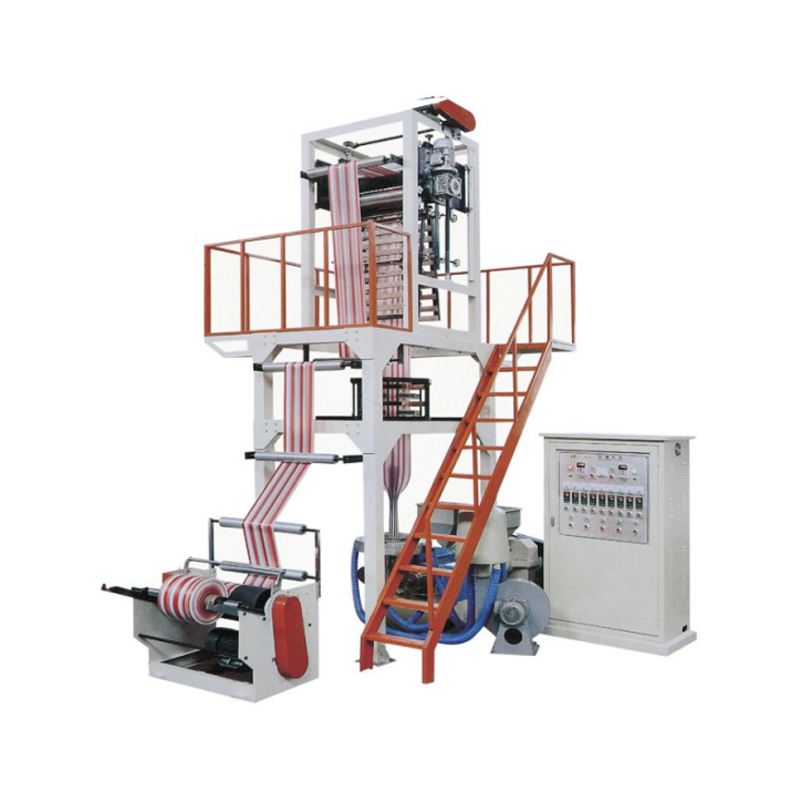Double Colour Strip Film Blower Machines: Expanding Creative and Functional Applications in Flexible Packaging
 By Admin
By Admin
The flexible packaging sector has seen growth and innovation over recent years, driven by evolving consumer demands, sustainability trends, and advances in manufacturing technologies. Among the innovations is the Double Colour Strip Film Blower Machine, a specialized blown film extrusion system capable of producing films with dual-color stripes or patterns in a continuous process. This technology opens new avenues not only in aesthetic appeal but also in functional applications across multiple industries.
Unlike standard single-color blown film lines, the double colour strip film blower machine integrates two or more polymer extruders with precise feed control to create films featuring vibrant contrasting stripes, bands, or gradients. This ability to produce visually distinctive films inline, without requiring additional printing or lamination steps, offers both cost efficiencies and design flexibility. Below, we explore the diverse application scenarios that leverage the unique performance characteristics of these machines.
Retail and Consumer Packaging: Eye-Catching Design Meets Functionality
One of the prevalent applications of double colour strip films is in retail packaging, where shelf impact and brand differentiation are crucial. Packaging films made with dual-color stripes are widely used for:
Shopping bags: Combining contrasting colors in strips creates attractive, high-visibility bags for supermarkets and boutiques. The stripes help brands stand out while offering the same durability and flexibility as conventional bags.
Produce bags: Colored stripes along lightweight polyethylene films assist consumers and retailers in easy product identification and sorting. For example, red-striped bags might be used for tomatoes while green stripes indicate leafy vegetables, streamlining inventory management.
Gift and promotional packaging: Films with decorative stripes serve seasonal or event packaging needs, enabling manufacturers to produce thematic designs without extra printing costs.
In all these scenarios, the double colour strip film blower machine’s capability to precisely control stripe width, spacing, and color combinations ensures consistent aesthetic quality that enhances consumer appeal.

Agricultural and Industrial Films: Enhanced Visibility and Identification
Beyond consumer packaging, the double colour strip film has functional benefits in agricultural and industrial applications where film color coding improves efficiency and safety.
Mulch films: Dual-color striped films are used in crop cultivation to provide effective weed suppression while also enabling farmers to quickly distinguish different types of films or treatments applied to fields. Stripes can also aid in thermal regulation and pest control, depending on color choice.
Construction and protective films: Color stripes on blown films improve visibility on job sites, enhancing safety by clearly marking covered areas or hazardous zones. This application is especially useful in barrier films used for dust containment or surface protection.
Shrink wrap and bundling: Striped films assist warehouse workers in identifying wrapped pallet contents or production batches, reducing errors in shipping and inventory management.
These industrial uses benefit from the machine’s ability to run long production cycles with color variation, ensuring operational consistency.
Food Packaging: Combining Barrier Performance with Brand Appeal
In the food packaging industry, where product protection and consumer attraction must go hand-in-hand, double colour strip films offer unique advantages:
Snack and confectionery wrappers: Striped films provide dynamic visual effects that catch shoppers’ eyes while maintaining barrier properties essential for freshness and shelf life.
Bread and bakery bags: Color striping helps brands distinguish product lines or flavors easily, improving shopper decision-making in stores.
Frozen food packaging: Dual-color films can integrate coded stripes that indicate different packaging dates or storage conditions, supporting traceability in cold chain logistics.
The ability to incorporate stripes during film extrusion streamlines manufacturing workflows by reducing the need for secondary printing processes, lowering production costs while enhancing product presentation.




